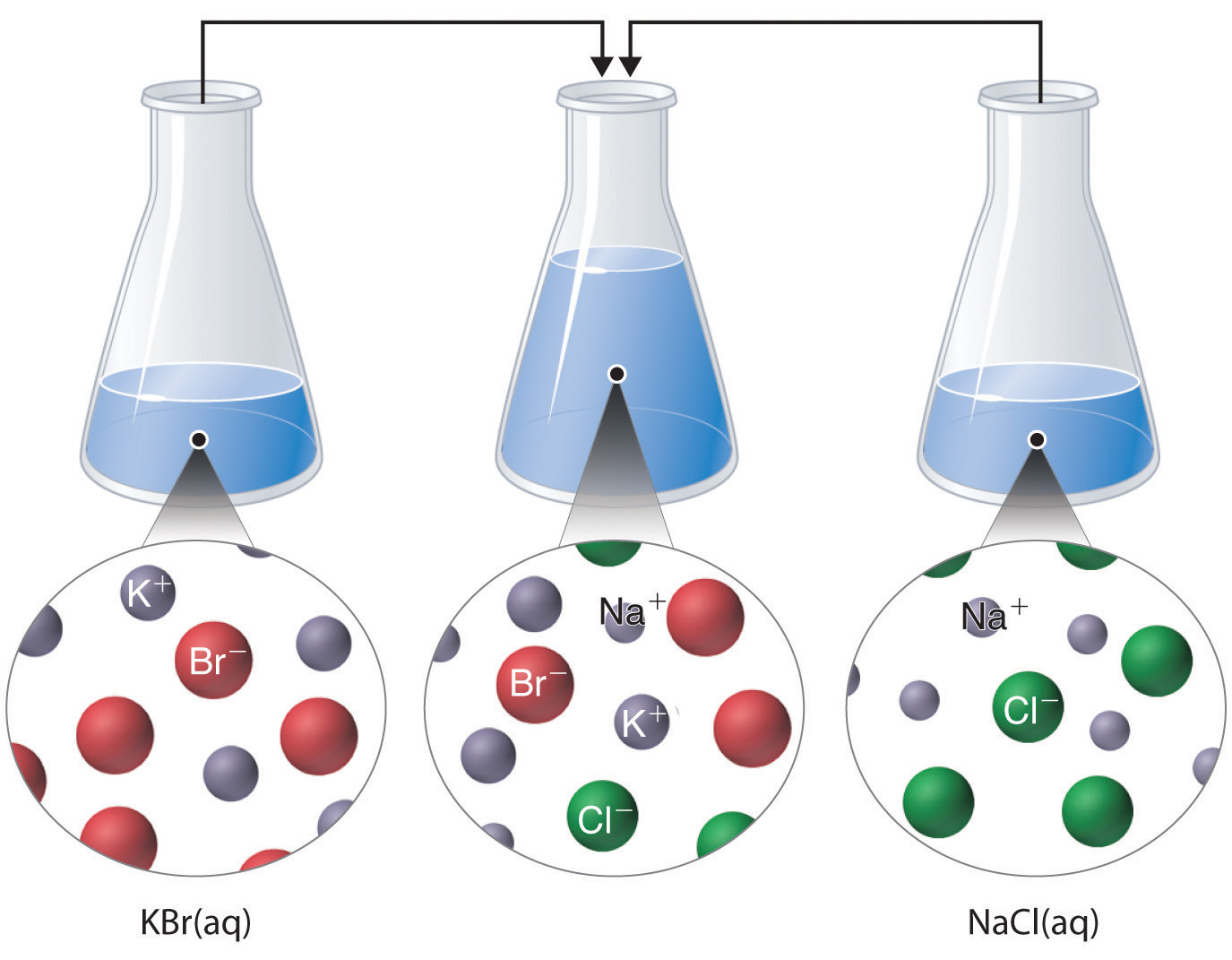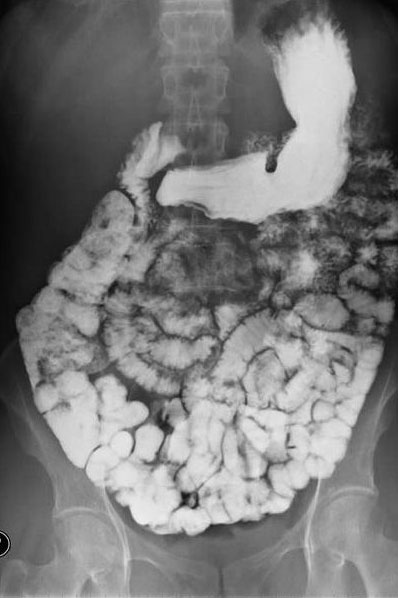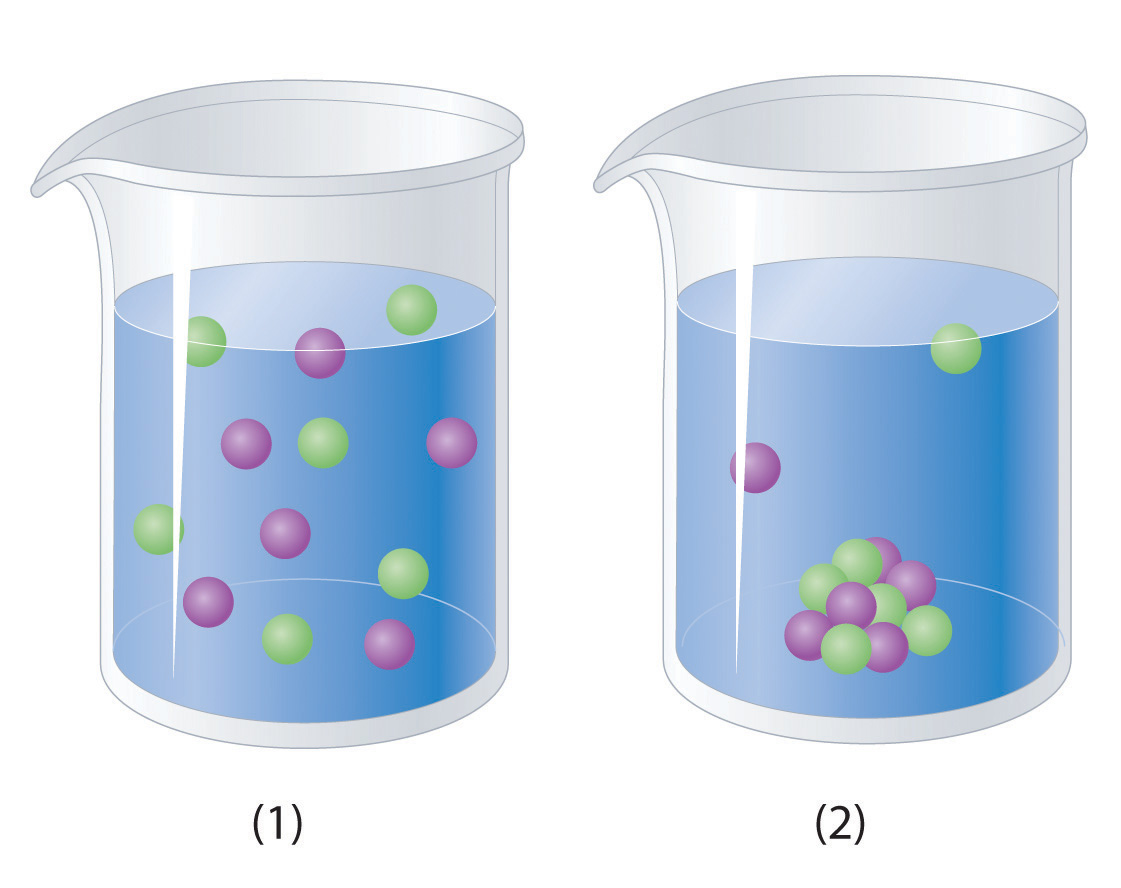This is "Unit 7", section 7.3 from the book General Chemistry (v. 1.0).
7.3 Precipitation Reactions
Learning Objective
- To identify a precipitation reaction and predict solubilities.
A precipitation reactionA subclass of an exchange reaction that yields an insoluble product (a precipitate) when two solutions are mixed. is a reaction that yields an insoluble product—a precipitateThe insoluble product that forms in a precipitation reaction.—when two solutions are mixed. An example of a precipitation reaction could be when a colorless solution of lead(II) nitrate is mixed with a colorless solution of potassium iodide to give a yellow precipitate of lead(II) iodide:
Equation 7.3(eq1)
Pb(NO3)2(aq) + 2KI(aq) → PbI2(s) + 2KNO3(aq)This equation has the general form of a precipitation reaction:
Equation 7.3(eq2)
Thus precipitation reactions occur between solutions of ionic compounds when one of the products is insoluble. Because both components of each compound change partners, such reactions are sometimes called double-displacement reactions. Two important uses of precipitation reactions are to isolate metals that have been extracted from their ores and to recover precious metals for recycling.
Video: Mixing potassium iodide solution and lead(II) nitrate solution together to initiate a precipitation reaction. Video Credit: Part of NCSSM CORE collection: http://www.dlt.ncssm. Please attribute this work as being created by the North Carolina School of Science and Mathematics. This work is licensed under Creative Commons CC-BY http://creativecommons.org/licenses/b... via YouTube
Predicting Solubilities
Table 7.3(1) gives guidelines for predicting the solubility of a wide variety of ionic compounds. To determine whether a precipitation reaction will occur, we identify each species in the solution and then refer to Table 7.3(1) to see which, if any, combination(s) of cation and anion are likely to produce an insoluble salt.
Table 7.3(1) Some Useful Solubility Rules
| These compounds generally dissolve in water (are soluble): | Exceptions: |
| Rule 1: All compounds of Li+, Na+, K+, Rb+, Cs+, and NH4+ | None |
| Rule 2: All compounds of NO3- and C2H3O2- | None |
| Rule 3: Compounds of Cl-, Br-, I- | Ag+, Hg22+, Pb2+ |
| Rule 4: Compounds of SO42- | Hg22+, Pb2+, Sr2+, Ba2+ |
| These compounds generally do not dissolve in water (are insoluble): | Exceptions: |
| Rule 5: Compounds of CO32- and PO43- | Compounds of Li+, Na+, K+, Rb+, Cs+, and NH4+ |
| Rule 6: Compounds of OH- | Compounds of Li+, Na+, K+, Rb+, Cs+, NH4+, Sr2+, and Ba2+ |
| Rule 7: Compounds of S2- | Compounds of Li+, Na+, K+, Rb+, Cs+, NH4+ |
Just as important as predicting the product of a reaction is knowing when a chemical reaction will not occur. Simply mixing solutions of two different chemical substances does not guarantee that a reaction will take place. For example, if aqueous NaCl solution is mixed with aqueous KBr solution, the components of the final mixture are unchanged. As you can see from table 7.3(1), all sodium and potassium salts are soluble, so no insoluble product can form. When these solutions are mixed, the only effect is to dilute each solution with the other (Figure 7.3(a) "The Effect of Mixing Aqueous KBr and NaCl Solutions").
Figure 7.3(a) The Effect of Mixing Aqueous KBr and NaCl Solutions

Because no net reaction occurs, the only effect is to dilute each solution with the other. (Water molecules are omitted from molecular views of the solutions for clarity.)
Another example of no reaction occuring appears in the video clip below:
Video: Mixing sodium chloride solution and nickel(II) sulfate solution together does not yield a precipitation reaction. Video Credit: Part of NCSSM CORE collection: http://www.dlt.ncssm. Please attribute this work as being created by the North Carolina School of Science and Mathematics. This work is licensed under Creative Commons CC-BY http://creativecommons.org/licenses/b... via YouTube
Example 7.3-1
Using the information in Table 7.3(1), predict what will happen in each case involving strong electrolytes. Write a balanced chemical equation for any reaction that occurs.
- Aqueous solutions of barium chloride and lithium sulfate are mixed.
- Aqueous solutions of rubidium hydroxide and cobalt(II) chloride are mixed.
- Aqueous solutions of strontium bromide and aluminum nitrate are mixed.
- Solid lead(II) acetate is added to an aqueous solution of ammonium iodide.
Given: reactants
Asked for: reaction and balanced chemical equation
Strategy:
A Identify the ions present in solution and write the products of each possible exchange reaction.
B Refer to Table 7.3(1) to determine which, if any, of the products is insoluble and will therefore form a precipitate. If a precipitate forms, write the balanced chemical equation for the reaction.
Solution:
A Both barium chloride and lithium sulfate dissociates completely in water to give a solution that contains the constituent anions and cations. Mixing the two solutions initially gives an aqueous solution that contains Ba2+, Cl−, Li+, and SO42− ions. The only possible exchange reaction is to form LiCl and BaSO4:

B We now need to decide whether either of these products is insoluble. Table 7.3(1) shows that LiCl is soluble in water (rules 1 and 3), but BaSO4 is not soluble in water (rule 4). Thus BaSO4 will precipitate according to the balanced chemical equation
BaCl2(aq) + Li2SO4(aq) → BaSO4(s) + 2LiCl(aq)Although soluble barium salts are toxic, BaSO4 is so insoluble that it can be used to diagnose stomach and intestinal problems without being absorbed into tissues. An outline of the digestive organs appears on x-rays of patients who have been given a “barium milkshake” or a “barium enema”—a suspension of very fine BaSO4 particles in water.

An x-ray of the digestive organs of a patient who has swallowed a “barium milkshake.” A barium milkshake is a suspension of very fine BaSO4 particles in water; the high atomic mass of barium makes it opaque to x-rays. Image Credit: Glitzy queen00 at en.wikipedia (Transferred from en.wikipedia) [Public domain], from Wikimedia Commons
A Rubidium hydroxide and cobalt(II) chloride are strong electrolytes, so when aqueous solutions of these compounds are mixed, the resulting solution initially contains Rb+, OH−, Co2+, and Cl− ions. The possible products of an exchange reaction are rubidium chloride and cobalt(II) hydroxide):

B According to Table 7.3(1) , RbCl is soluble (rules 1 and 3), but Co(OH)2 is not soluble (rule 6). Hence Co(OH)2 will precipitate according to the following balanced chemical equation:
CoCl2(aq) + 2RbOH(aq) → Co(OH)2(s) + 2RbCl(aq)A When aqueous solutions of strontium bromide and aluminum nitrate are mixed, we initially obtain a solution that contains Sr2+, Br−, Al3+, and NO3− ions. The two possible products from an exchange reaction are aluminum bromide and strontium nitrate:

B According to Table 7.3(1), both AlBr3 (rule 3) and Sr(NO3)2 (rule 2) are soluble. Thus no net reaction will occur.
A According to Table 7.3(1), lead(II) acetate is soluble (rule 2). Thus solid lead acetate dissolves in water to give Pb2+ and CH3CO2− ions. Because the solution also contains NH4+ and I− ions, the possible products of an exchange reaction are ammonium acetate and lead(II) iodide:

B According to Table 7.3(1), ammonium acetate is soluble (rules 1 and 2), but PbI2 is insoluble (rule 3). Thus Pb(C2H3O2)2 will dissolve, and PbI2 will precipitate. The balanced chemical equation is as follows:
Pb(C2H3O2)2(aq) + 2KI(aq) → PbI2(s) + NH4C2H3O2(aq)
Exercise
Using the information in Table 7.3(1), predict what will happen in each case involving strong electrolytes. Write the balanced chemicalc equation for any reaction that occurs.
- An aqueous solution of strontium hydroxide is added to an aqueous solution of iron(II) chloride.
- Solid potassium phosphate is added to an aqueous solution of mercury(II) perchlorate.
- Solid sodium fluoride is added to an aqueous solution of ammonium formate.
- Aqueous solutions of calcium bromide and cesium carbonate are mixed.
Answer:
- FeCl2(aq) + Sr(OH)2(aq) → Fe(OH)2(s) + SrCl2(aq)
- 2K3PO4(aq) + 3Hg(ClO4)2(aq) → Hg3(PO4)2(s) + 6KClO4(aq)
- NaF(s) dissolves; no net reaction
- CaBr2(aq) + Cs2CO3(aq) → CaCO3(s) + 2CsBr(aq)
Summary
In a precipitation reaction an insoluble material (a precipitate) forms when solutions of two substances are mixed. To predict the product of a precipitation reaction, all species initially present in the solutions are identified, as are any combinations likely to produce an insoluble salt.
Key Takeaway
- Predicting the solubility of ionic compounds in water can give insight into whether or not a reaction will occur.
Conceptual Problems
-
Predict whether mixing each pair of solutions will result in the formation of a precipitate. If so, identify the precipitate.
- FeCl2(aq) + Na2S(aq)
- NaOH(aq) + H3PO4(aq)
- ZnCl2(aq) + (NH4)2S(aq)
- Mg(C2H3O2)2(aq) + K3PO4(aq)
- Na2SO4(aq) + K3PO4(aq)
- CaCl2(aq) + KNO3(aq)
-
Predict whether mixing each pair of solutions will result in the formation of a precipitate. If so, identify the precipitate.
- KOH(aq) + H3PO4(aq)
- K2CO3(aq) + BaCl2(aq)
- Ba(NO3)2(aq) + Na2SO4(aq)
-
Which representation best corresponds to an aqueous solution originally containing each of the following?
- 1 M NH4Cl
- 1 M NaO2CCH3
- 1 M NaOH + 1 M HCl
1 M Ba(OH)2 + 1 M H2SO4

-
Which representation in Problem 3 best corresponds to an aqueous solution originally containing each of the following?
- 1 M CH3CO2H + 1 M NaOH
- 1 M NH3 + 1 M HCl
- 1 M Na2CO3 + 1 M H2SO4
- 1 M CaCl2 + 1 M H3PO4
Answer
-
- forms a precipitate of FeS
- no precipitate is formed
- forms a precipitate of ZnS
- forms a precipitate of Mg3(PO4)2
- no precipitate is formed
- no precipitate is formed
-
-
- 1
- 1
- 1
- 2
-





